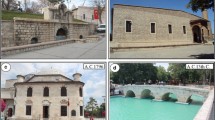Abstract
The preventive conservation is based on acting on the causes of deterioration of cultural heritage to minimise damage, extending its lifetime and minimising the costs of restoration. In this paper, a quantitative method of recording and assessment of damage in frescoes is presented. Damage mapping has been performed with a colour scale of six values for two fresco paintings of two walls at Ariadne’s House (Pompeii, Italy); subsequently, this information has been transferred to a data matrix which and statistical analysis of Variance (ANOVA) has been applied. ANOVA results show significant differences for the vertical and the horizontal axis depending on the different stages of damage. These differences also depend on the wall, which may be due to intrinsic differences such as materials of different restorations, the orientation of the wall, etc. or extrinsic differences and variations in temperature, relative humidity, etc. This methodology may be used in the future to quantify the influence of different variables on the extent of the deterioration of the paint layer, as for example determine and monitor its correlation to salts analytics in a determined facing.









Similar content being viewed by others
References
Arnold A, Zehnder K (1996) Monitoring wall paintings affected by soluble salts. In: Cather S (ed) The conservation of wall paintings, 2nd edn. Courtauld Institute of Art and the Getty Conservation Institute, London, pp 103–136
Goudie AS, Viles HA (1997) Salt weathering hazards. Wiley, London
Guarneri M, Danielis A, Francucci M, De Collibus MF, Fornetti G, Mencattini A (2014) 3D remote colorimetry and watershed segmentation techniques for fresco and artwork decay monitoring and preservation. J Archaeol Sci 46(1):182–190. doi:10.1016/j.jas.2014.02.020
Hamamcioglu-Turan M, Akbaylar I (2011) Documentation of historic structures for the assessment of heritage characteristics. J Archit Plan Res 28(2):129
Merello P, García-Diego FJ, Zarzo M (2012) Microclimate monitoring of Ariadne’s House (Pompeii, Italy) for preventive conservation of fresco paintings. Chem Cent J 6:145. doi:10.1186/1752-153X-6-145
Merello P, García-Diego FJ, Zarzo M (2013) Evaluation of corrective measures implemented for the preventive conservation of fresco paintings in Ariadne’s House (Pompeii, Italy). Chem Cent J 7(1):87. doi:10.1186/1752-153X-7-87
Myra J, Giesena A, Ungb P, Warkec A, Christgenb B, Mazela AD, Grahamb DW (2014) Condition assessment and preservation of open-air rock art panels during environmental change. J Cult Herit 15:49–56. doi:10.1016/j.culher.2013.01.013
Nevin A, Melia JL, Osticioli I, Gautier G, Colombini MP (2008) The identification of copper oxalates in a 16th century Cypriot exterior wall painting using micro FTIR, micro Raman spectroscopy and Gas Chromatography-Mass Spectrometry. J Cult Herit. 9:154–161. doi:10.1016/j.culher.2007.10.002
O’Brien P (1990) An experimental study of the effects of salt erosion on pottery. J Archaeol Sci 17(4):393–401. doi:10.1016/0305-4403(90)90004-O
Pérez MC, Garcia-Diego FJ, Merello P, D’Antoni P, Fernández Navajas A, Ribera i Lacomba A, Ferrazza L, Pérez-Miralles J, Baró JL, Merce P, D’Antoni H, Curiel J (2013) Ariadne´s house (Pompeii, Italy) wall paintings: a multidisciplinary study of its present state focused on a future restoration and preventive conservation. Mater Construcc 63(311):449–467. doi:10.3989/mc.2012.00812
Pesando F (1997) Domus: edilizia privata e società pompeiana fra III e I secolo a.C., “L’Erma” di Bretschneider, Rome
Pesando F (2007) La Casa de Ariadna de Pompeya: redescubrimiento de una domus. In: Ribera A, Olcina M, Ballester C (eds) Pompeya bajo Pompeya, Las excavaciones en la Casa de Ariadna. Museo Arqueológico Provincial de Alicante (MARQ), Valencia, pp 21–23
Rodriguez-Navarro C, Doehne E (1999) Salt weathering: influence of evaporation rate, supersaturation and crystallization pattern. Earth Surf Process Landf 24:191–209. doi:10.1002/(SICI)1096-9837(199903)24:3<191:AID-ESP942>3.0.CO;2-G
Ruiz-agudo E, Lubelli B, Sawdy A, Van Hees R, Price C, Rodriguez-Navarro C (2011) An integrated methodology for salt damage assessment and remediation: the case of San Jerónimo Monastery (Granada, Spain). Environ Earth Sci 63(7):1475–1486. doi:10.1007/s12665-010-0661-9
Statgraphics Software 5.1. Available online. http://www.statgraphics.net/. Accessed 18 March 2015
Warke PA, Curran JM, Turkington AV, Smith BJ (2003) Condition assessment for building stone conservation: a staging system approach. Build Environ 38:1113–1123. doi:10.1016/S0360-1323(03)00085-4
Weritz F, Kruschwitz S, Maierhofer C, Wendrich A (2009) Assessment of moisture and salt contents in brick masonry with microwave transmission, spectral-induced polarization, and laser-induced breakdown spectroscopy. Int J Archit Herit 3(2):126–144. doi:10.1080/15583050802278992
Winkler EM (1994) Stone in architecture. Springer, Berlin Heidelberg
Wüst R, Schlüchter C (2000) The origin of soluble salts in rocks of the Thebes mountains, Egypt: the damage potential to ancient Egyptian wall art. J Archaeol Sci 27(12):1161–1172. doi:10.1006/jasc.1999.0550
Acknowledgments
This work was partially supported by the Spanish Government (Ministerio de Economía y Competitividad) under projects HAR2013-47895-C2-1-P and HAR2013-47895-C2-2-P. This publication is part of the programme of valorisation and combined resources of the I + D + i of VLC/CAMPUS and has been partially supported by the Ministry of Education, Culture and Sports as part of the programme of international excellence campus (PAID 06-14).
Author information
Authors and Affiliations
Corresponding author
Ethics declarations
Conflict of interest
The authors declare that they have no conflict of interest.
Additional information
P. Merello, P. Beltrán and F.-J. García-Diego contributed equally to this work.
Rights and permissions
About this article
Cite this article
Merello, P., Beltrán, P. & García-Diego, FJ. Quantitative non-invasive method for damage evaluation in frescoes: Ariadne’s House (Pompeii, Italy). Environ Earth Sci 75, 165 (2016). https://doi.org/10.1007/s12665-015-5066-3
Received:
Accepted:
Published:
DOI: https://doi.org/10.1007/s12665-015-5066-3




